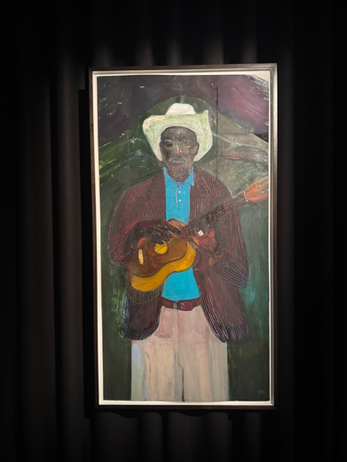Peter Doig
Serpentine Gallery
Coming to Peter Doig's House of Music at the Serpentine Gallery was entering a familiar dream, one that blurs quietly with color and memory. His paintings of musicians, dancers, and flickering lights reminded me how painting can hold both the stillness and the rhythm of life. Even the velvet carpets that lined the gallery floor seemed to extend the paintings beyond their frames, their texture and deep hue blending with Doig's colors almost as if you had stepped into the painting. What resonated most with me was the way he painted memory—not as something fixed, but fluid, alive. His figures often appear suspended between celebration and solitude, echoing that delicate tension between togetherness and isolation that I often try to capture in my own works about intimacy and daily life.
I have never been to Trinidad, but in that gallery—surrounded by his soundtracks, the soft carpets, and the pulsing warmth of color—I was transported there. The atmosphere vibrated with rhythm; it was as if the city itself breathed through the walls.
There's a cinematic distance in his work, yet it's deeply personal. I found myself thinking about how I paint domestic spaces and quiet gestures—how to let emotion breathe through light and color without forcing it. Doig's paintings don't describe; they translate feeling into form.
House of Music reminded me that painting can be both an act of remembering and of listening—a slow rhythm unfolding on canvas. Standing before those dreamlike scenes, I felt a renewed trust in painting’s ability to speak through silence, to carry fragments of time, and to turn the everyday into something tenderly transcendent.
Kiefer/Van Gogh
Royal Academy
I saw the Kiefer & Van Gogh exhibition at the Royal Academy with my boyfriend, mainly drawn by my love for Van Gogh. His paintings have always felt like letters — honest, emotional, and full of trembling life. I had seen Van Gogh's works in other shows, but this time, seeing them presented along with the monumental canvases of Anselm Kiefer created a whole new dialogue.
Kiefer's works are phenomenal in scale and materiality: the surfaces are rough, layered with thick impasto, straw, and even real branches that push out from the canvas. Looking at them, I felt as if I stood in the rye fields he painted; one could almost smell the earth and the texture. His works don't just depict landscape; they become it.
From the gallery zine, I gathered that Kiefer has been influenced by Van Gogh for many years; he once took a journey through the very landscapes of France where Van Gogh had walked. It's a connection that feels deeply poetic-one artist walking through another's memory, reimagining it through his time and pain.
My favorite was Starry Night. Before which stood an astonishing installation, a sculptural echo of the painting-fragile yet monumental in its presence. To perceive it was immersive, almost spiritual. I could sense Kiefer's respect for Van Gogh not through imitation but through empathy.
Wayne Thiebaud was the artist who first inspired me to paint. I still remember the first oil painting I made in high school — a copy of his famous cake painting. As a child, I was enchanted by his pure, simple colours and the candy-like world he created. There was something innocent and joyful in his work that I deeply longed for.
When I heard about his exhibition at The Courtauld Gallery, I was so excited. During my postgraduate study, being able to see his original works felt very special, almost like meeting an old friend from my past. The show was not large, and most of the works were ones I had already seen in books. But seeing them in person, I was completely mesmerised by the texture, the brushstrokes, and the luminous layers of colour. The surface carried a kind of quiet magic that no reproduction could ever show.
Standing in front of his paintings, I started to understand them differently. I think what he paints is not just cakes or landscapes, but something much deeper — the feeling of a past we can never return to, the pure and gentle sadness of childhood.
In the elevator after the show, I overheard two visitors talking. One said, “Wayne Thiebaud is not my top favourite artist, but I absolutely love him.” That line stayed with me. I thought, maybe one day I could be an artist like that too. Maybe my work won’t be considered the most powerful or the most important, but if it can bring people a sense of calm, warmth, or joy when they look at it — that would already be enough for me.
The Courtauld Gallery

































